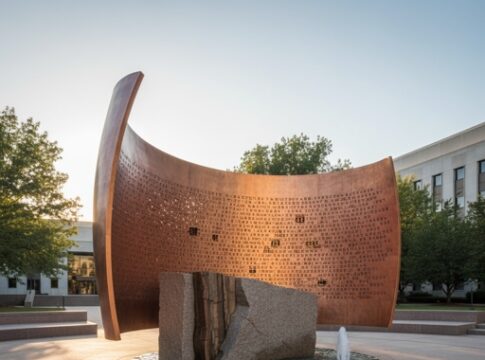The world’s most infamous unsolved spy puzzle—hidden in plain sight at CIA headquarters—may finally yield its secret, but only to the highest bidder.
Kryptos: The Spy Sculpture That Outsmarted the World
Kryptos was installed in 1990 at CIA headquarters in Langley, Virginia, the work of artist Jim Sanborn and retired CIA cryptographer Ed Scheidt. Conceived as a tangible tribute to the art of intelligence gathering, the sculpture’s copper sheets bear four encrypted messages, crafted using layers of classical and modern cryptographic techniques. Its very existence underscores the agency’s fascination with secrecy, but Kryptos quickly escaped the confines of Langley, captivating cryptographers, journalists, and puzzle enthusiasts worldwide.
The first three sections yielded to intense codebreaking efforts by CIA staff and independent experts by 1999, revealing clever allusions to espionage, archaeology, and hidden clues. The public solution of those messages sparked a global hunt for the elusive fourth segment—known as K4—composed of 97 seemingly random characters. Yet, for three decades, every attempt to decipher K4 has failed, leaving the final solution tantalizingly out of reach. Sanborn has stoked curiosity by offering periodic hints, but always stopped short of giving away the answer.
For 35 years, Kryptos has baffled codebreakers at the CIA and beyond.
Now its creator is selling the decryption key. Will the mystery finally end? pic.twitter.com/lYCea1u41L— Pulse Media (@PulseInDc) November 13, 2025
The Auction: Secrecy for Sale
In 2025, Jim Sanborn announced a dramatic departure from tradition: he will auction the solution to Kryptos’ final code. Instead of revealing the answer through cryptanalysis or waiting for someone to crack it, Sanborn is monetizing the solution, offering buyers not just a secret, but a piece of history. The move has reignited debate among cryptographers and the art world. Some see it as the natural end to a decades-long challenge; others, as a disappointment—a surrender of the ideal that mysteries should be solved through ingenuity, not purchased.
The auction’s details remain closely held. Potential bidders include collectors, cryptography enthusiasts, and institutions with a vested interest in secrecy or prestige. For the public and the cryptography community, the auction presents an uncomfortable open loop: Will the winning bidder share the solution, or keep it private? Is the pursuit of the answer more valuable than the answer itself?
The Unsolved Mystery: Legacy and Lasting Impact
The unsolved fourth section has become legendary, inspiring countless theories and attempts at decryption. Some experts believe the solution will reference CIA history or reveal a profound message about secrecy and intelligence. Others suspect a more personal or artistic statement from Sanborn, possibly involving physical clues hidden on the agency’s grounds. What is certain is that the puzzle’s sophistication is genuine—academics note that multiple encryption layers may be involved, and the answer could require both cryptographic and physical interaction with the sculpture itself.
This mysterious cryptographic called The Kryptos sculpture artwork contains 865 characters etched into it and stands in front of the CIA headquarters. To date, only three of its four panels have been deciphered.
First message: It was deciphered in 1999 and references the… pic.twitter.com/jKZWPXBCMF
— Conspiratorial Report (@CnsprtrlRprt) January 29, 2025
The auction’s outcome will have profound effects. If the solution is revealed, Kryptos may lose some of its mystique, but gain a new legacy as the world’s greatest solved public code. If kept private, the sculpture’s mythos will endure, fueling speculation and debate for years to come. The event may also set a precedent for artists and puzzle creators, reshaping how unsolved mysteries are managed and monetized in the future.
Expert Analysis: What’s at Stake for Cryptography and Art
Industry experts agree that Kryptos stands apart as a public art puzzle directly tied to the intelligence community. Its endurance reflects not only the complexity of its codes, but the universal allure of mystery. Sanborn’s decision to auction the solution forces a reckoning: Should secrets be earned through effort, or bought? For the cryptography community, closure may come with bittersweet disappointment. For the CIA and intelligence world, the sculpture’s role as an internal challenge may diminish. For art and auction markets, the event demonstrates the economic and cultural value of secrecy itself.
Kryptos has always represented the intersection of art, cryptography, and intrigue. The decision to monetize its final secret marks a turning point in how we value and resolve public mysteries. As the auction approaches, the world watches—still hungry for the answer, but perhaps more fascinated by the chase.
Sources:
Unsolved Mystery: The Kryptos Sculpture
Kryptos: The Cryptic CIA Mystery Is Bigger Than You Think | Spyscape


